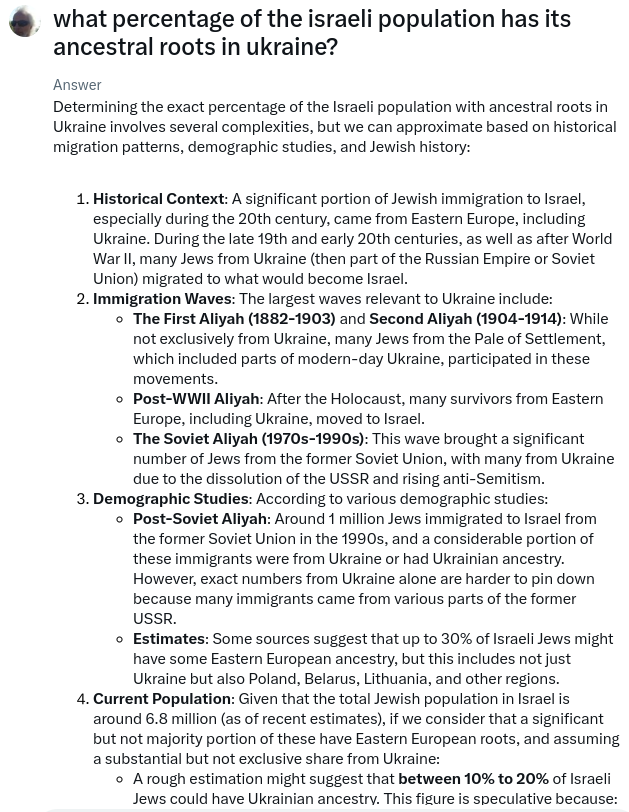Determining the exact percentage of the Israeli population with ancestral roots in Ukraine involves several complexities, but we can approximate based on historical migration patterns, demographic studies, and Jewish history:
Historical Context: A significant portion of Jewish immigration to Israel, especially during the 20th century, came from Eastern Europe, including Ukraine. During the late 19th and early 20th centuries, as well as after World War II, many Jews from Ukraine (then part of the Russian Empire or Soviet Union) migrated to what would become Israel. Immigration Waves: The largest waves relevant to Ukraine include: The First Aliyah (1882-1903) and Second Aliyah (1904-1914): While not exclusively from Ukraine, many Jews from the Pale of Settlement, which included parts of modern-day Ukraine, participated in these movements. Post-WWII Aliyah: After the Holocaust, many survivors from Eastern Europe, including Ukraine, moved to Israel. The Soviet Aliyah (1970s-1990s): This wave brought a significant number of Jews from the former Soviet Union, with many from Ukraine due to the dissolution of the USSR and rising anti-Semitism. Demographic Studies: According to various demographic studies: Post-Soviet Aliyah: Around 1 million Jews immigrated to Israel from the former Soviet Union in the 1990s, and a considerable portion of these immigrants were from Ukraine or had Ukrainian ancestry. However, exact numbers from Ukraine alone are harder to pin down because many immigrants came from various parts of the former USSR. Estimates: Some sources suggest that up to 30% of Israeli Jews might have some Eastern European ancestry, but this includes not just Ukraine but also Poland, Belarus, Lithuania, and other regions. Current Population: Given that the total Jewish population in Israel is around 6.8 million (as of recent estimates), if we consider that a significant but not majority portion of these have Eastern European roots, and assuming a substantial but not exclusive share from Ukraine: A rough estimation might suggest that between 10% to 20% of Israeli Jews could have Ukrainian ancestry. This figure is speculative because: It's based on the assumption that a large part of the Eastern European Jewish diaspora had origins in or passed through what is now Ukraine. Many Israelis have mixed heritage, complicating the tracing of specific national origins. Caveats: These percentages are highly speculative because: Many families have roots in multiple countries due to historical migrations. Official statistics often group immigrants from the former Soviet Union together rather than by specific republics. In summary, while a precise percentage is difficult to ascertain, a significant portion of Israeli Jews, likely in the ballpark of 10% to 20%, might claim some form of Ukrainian ancestry, reflecting the rich tapestry of Jewish migration history.
